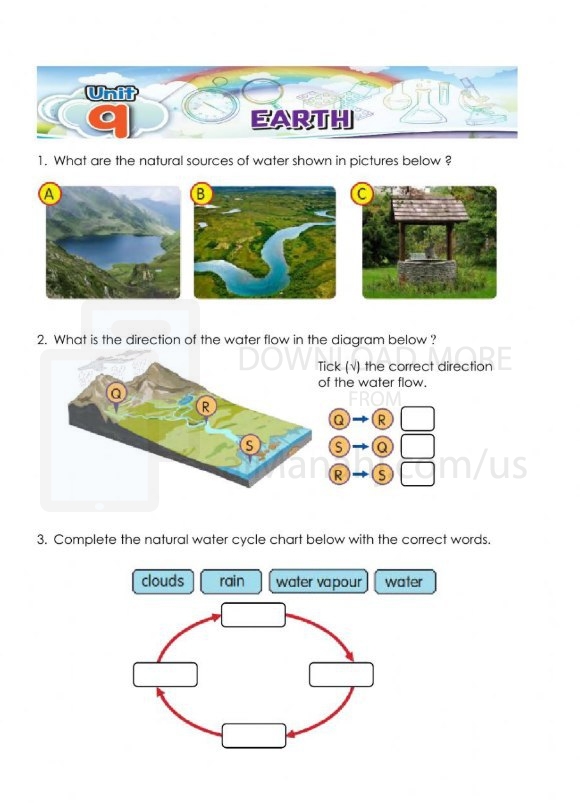| You are here: Almanahj Website ⇒ American curriculum ⇒ 2nd Grade ⇒ Geology ⇒ Term 1 | ||
|---|---|---|
Worksheet about Natural sources of water | ||
|---|---|---|
| Subject: Geology | ||
| 2nd Grade | ||
| Term 1 | ||
| Year: 2023/2024 | ||
| Size: 224KB | ||
| Number of clicks: 128 | ||
| Publish date:November 26, 2023 | ||
| Added by: Eman | ||
| Last download date: 2024-09-09 13:03:17 | By: theodor JOSLYNNE | |
| File info: Natural sources of water refer to bodies of water that occur naturally on Earth, without human intervention. These sources play a vital role in sustaining life and supporting ecosystems. Here are some common natural sources of water: 1. Oceans: Oceans are the largest bodies of water on Earth, covering about 71% of the planet's surface. They contain saltwater and are home to a diverse range of marine life. 2. Seas: Seas are smaller bodies of saltwater that are partially enclosed by land. Examples include the Mediterranean Sea, Caribbean Sea, and the Red Sea. 3. Lakes: Lakes are inland bodies of water that are typically surrounded by land. They can vary in size, from small ponds to massive lakes like the Great Lakes in North America or Lake Baikal in Russia. Lakes can be freshwater or saline, depending on their location and geological characteristics. 4. Rivers: Rivers are flowing bodies of freshwater that typically originate from mountainous areas or springs. They flow downhill, usually merging with other rivers or eventually emptying into oceans, seas, or lakes. Rivers are crucial for providing freshwater to ecosystems, wildlife, and human communities. 5. Streams and Creeks: Streams and creeks are smaller flowing bodies of water that are often tributaries of larger rivers. They are characterized by their shallower depth and narrower width compared to rivers. 6. Springs: Springs are formed when groundwater emerges naturally from the Earth's surface. They occur when an aquifer, a layer of permeable rock or sediment, intersects the surface. 7. Ponds: Ponds are small bodies of standing freshwater, usually shallower than lakes. They can be natural or human-made and provide habitats for various plants and animals. 8. Wetlands: Wetlands are areas where the land is saturated or covered with water for a significant part of the year. They include marshes, swamps, and bogs. Wetlands play a crucial role in water purification, flood control, and providing habitat for numerous species. 9. Glaciers: Glaciers are large bodies of ice that form in high-altitude areas and slowly move downhill due to their own weight. They store a significant amount of freshwater and release it gradually, contributing to river systems. These natural sources of water are essential for sustaining ecosystems, supporting biodiversity, and providing freshwater for human needs. They are interconnected through the water cycle, which involves processes like evaporation, condensation, precipitation, and runoff. | ||
| Downloading link Worksheet about Natural sources of water |
|---|
|
1700984648.pdf
The file is being prepared for download
|
| File images |
|---|
 |